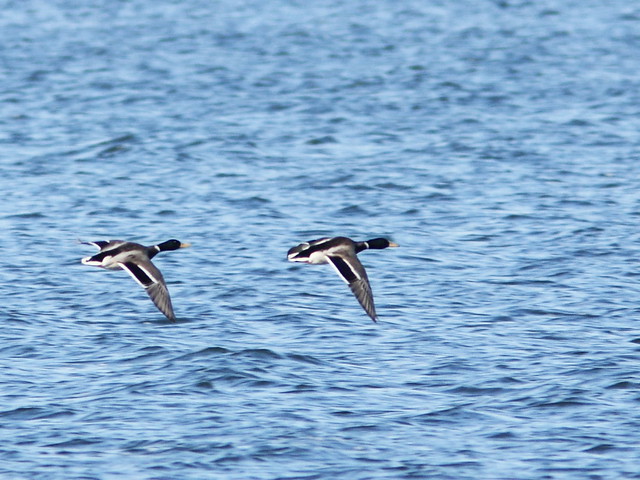
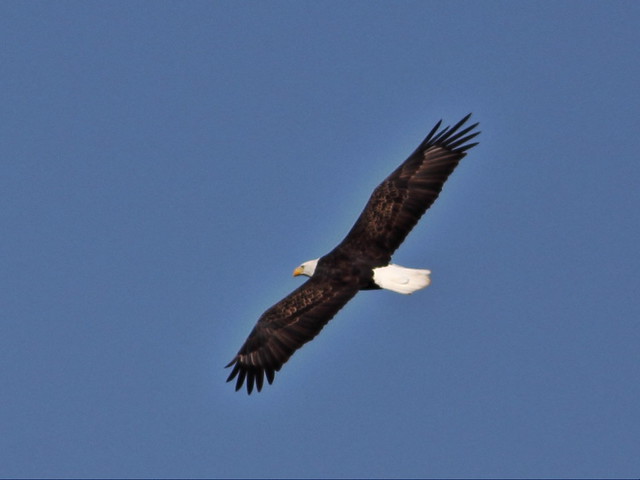
By the time we were ready to return home to Florida at the end of October, the winter sparrows began showing up in fresh plumage.
White-throated Sparrows sported their golden lores;


White-crowned Sparrows are notably larger than their white-throated relatives and breed on the Canadian tundra. This one suddenly appeared on the deck of our daughter's home and posed very cooperatively:

The immature White-crowned Sparrow has a buffy crown but this does not detract from its beauty:

Song Sparrows are seen all year, but the local breeders fly south in the winter and are replaced by migrants from the north:

Larger and more richly colored Fox Sparrows followed:
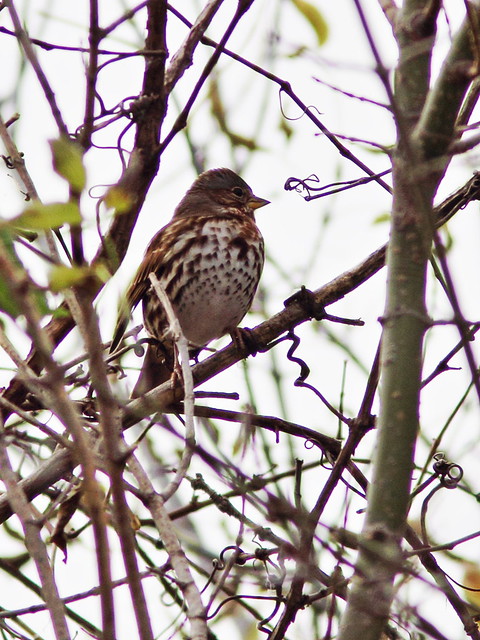
Ruby-crowned Kinglets move through after most of the warblers have departed, and will linger until cold weather sets in:

Kinglets are active feeders, "hover-gleaning" for insects in the tips of branches:

Hardy (Slate-colored) Dark-eyed Juncos, commonly called "Snow Birds," will remain all winter:


Canada Geese arrived by the thousands in V-formation flocks, joining the permanent resident population. This video captures the sense of being immersed in the wild echoing calls of flocks of geese as they fly overhead. Many settled into the small pond in Jones Meadow Park, very close to our condo. Try to ignore the passing airliner! (If video does not display in the space below, please visit this link.)
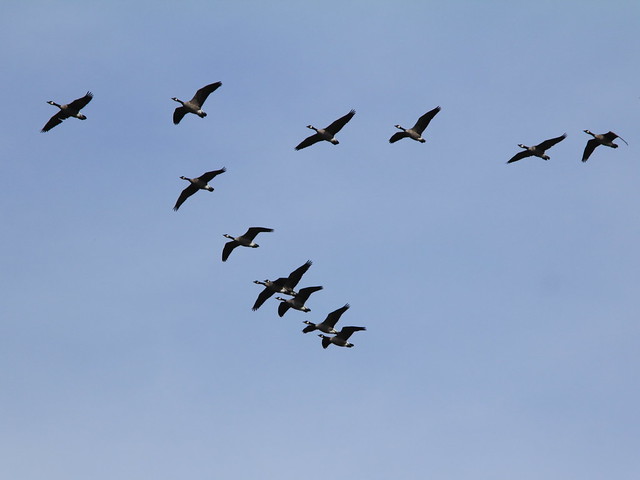

 These migrating geese come in two distinctly recognizable sizes. The smaller ones actually represent a separate species, the Cackling Goose, which breeds high in the arctic tundra and spends winter more to the south. The four in the foreground exhibit not only smaller size, but short necks, rounder heads and stubbier bills:
These migrating geese come in two distinctly recognizable sizes. The smaller ones actually represent a separate species, the Cackling Goose, which breeds high in the arctic tundra and spends winter more to the south. The four in the foreground exhibit not only smaller size, but short necks, rounder heads and stubbier bills:  Three Canada Geese are joined by a Pied-billed Grebe:
Three Canada Geese are joined by a Pied-billed Grebe: 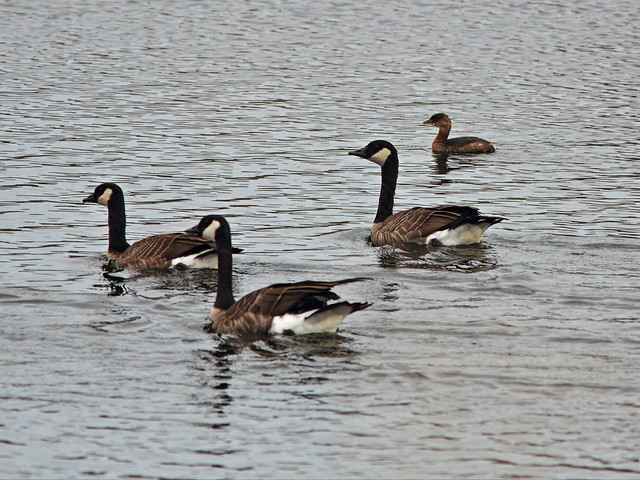 The number and variety of birds was down, but in contrast to their muted plumage, the fall colors were superb. This is something that we really miss in Florida, where the Wet Season simply transitions into the Dry Season without fanfare around the middle of October. At Hawk's Bluff Park near our daughter's home in Batavia, Illinois this magnificent Oak provided copper highlights:
The number and variety of birds was down, but in contrast to their muted plumage, the fall colors were superb. This is something that we really miss in Florida, where the Wet Season simply transitions into the Dry Season without fanfare around the middle of October. At Hawk's Bluff Park near our daughter's home in Batavia, Illinois this magnificent Oak provided copper highlights:  The Cottonwoods along Mill Creek added gold to the palette:
The Cottonwoods along Mill Creek added gold to the palette: 
 In early October we had already experienced a few snow flurries, so we were a bit apprehensive about our daughter's invitation to join her family for a long mid-October weekend over 200 miles to the north in Sturgeon Bay, Wisconsin. The city straddles the namesake inlet and bay that connects Lake Michigan with Green Bay. We were pleasantly surprised to find cloudless skies and fair temperatures. From the lawn of our condo on the bay, sunset was serene and colorful despite the clear sky:
In early October we had already experienced a few snow flurries, so we were a bit apprehensive about our daughter's invitation to join her family for a long mid-October weekend over 200 miles to the north in Sturgeon Bay, Wisconsin. The city straddles the namesake inlet and bay that connects Lake Michigan with Green Bay. We were pleasantly surprised to find cloudless skies and fair temperatures. From the lawn of our condo on the bay, sunset was serene and colorful despite the clear sky:  At a local farm, Sugar Maples were in fine color:
At a local farm, Sugar Maples were in fine color:  Large flocks of migrating ducks followed Sturgeon Bay southward. This flock consisted of over 20 Redheads with a Red-breasted Merganser taking up the lead position.
Large flocks of migrating ducks followed Sturgeon Bay southward. This flock consisted of over 20 Redheads with a Red-breasted Merganser taking up the lead position.
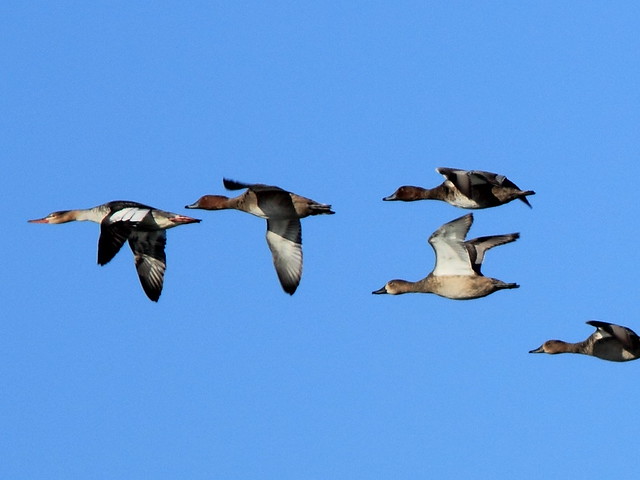 Hundreds of Horned Grebes foraged just offshore. This was the first time I ever was able to photograph this species, though the images suffered because the sun was behind the birds:
Hundreds of Horned Grebes foraged just offshore. This was the first time I ever was able to photograph this species, though the images suffered because the sun was behind the birds:  These two Mallard drakes, though seen at a distance, were in better light:
These two Mallard drakes, though seen at a distance, were in better light: 